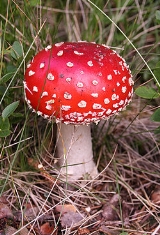
Mushroom
Overview
A mushroom is the fleshy, spore
-bearing fruiting body
of a fungus
, typically produced above ground on soil or on its food
source. The standard for the name "mushroom" is the cultivated white button mushroom, Agaricus bisporus; hence the word "mushroom" is most often applied to those fungi (Basidiomycota
, Agaricomycetes
) that have a stem (stipe
), a cap (pileus
), and gills (lamellae, sing. lamella) or pores on the underside of the cap.
"Mushroom" describes a variety of gilled fungi, with or without stems, and the term is used even more generally, to describe both the fleshy fruiting bodies of some Ascomycota
and the woody or leathery fruiting bodies of some Basidiomycota
, depending upon the context of the word.
Forms deviating from the standard morphology
usually have more specific names, such as "puffball
", "stinkhorn
", and "morel
", and gilled mushrooms themselves are often called "agaric
s" in reference to their similarity to Agaricus
or their place Agaricales
.
Spore
In biology, a spore is a reproductive structure that is adapted for dispersal and surviving for extended periods of time in unfavorable conditions. Spores form part of the life cycles of many bacteria, plants, algae, fungi and some protozoa. According to scientist Dr...
-bearing fruiting body
Sporocarp (fungi)
In fungi, the sporocarp is a multicellular structure on which spore-producing structures, such as basidia or asci, are borne...
of a fungus
Fungus
A fungus is a member of a large group of eukaryotic organisms that includes microorganisms such as yeasts and molds , as well as the more familiar mushrooms. These organisms are classified as a kingdom, Fungi, which is separate from plants, animals, and bacteria...
, typically produced above ground on soil or on its food
Food
Food is any substance consumed to provide nutritional support for the body. It is usually of plant or animal origin, and contains essential nutrients, such as carbohydrates, fats, proteins, vitamins, or minerals...
source. The standard for the name "mushroom" is the cultivated white button mushroom, Agaricus bisporus; hence the word "mushroom" is most often applied to those fungi (Basidiomycota
Basidiomycota
Basidiomycota is one of two large phyla that, together with the Ascomycota, comprise the subkingdom Dikarya within the Kingdom Fungi...
, Agaricomycetes
Agaricomycetes
Agaricomycetes is a class of fungi. The taxon is roughly identical to that defined for the Homobasidiomycetes by Hibbett & Thorn, with the inclusion of Auriculariales and Sebacinales. It includes not only mushrooms but also most species placed in the deprecated taxa Gasteromycetes and...
) that have a stem (stipe
Stipe (mycology)
thumb|150px|right|Diagram of a [[basidiomycete]] stipe with an [[annulus |annulus]] and [[volva |volva]]In mycology a stipe refers to the stem or stalk-like feature supporting the cap of a mushroom. Like all tissues of the mushroom other than the hymenium, the stipe is composed of sterile hyphal...
), a cap (pileus
Pileus (mycology)
The pileus is the technical name for the cap, or cap-like part, of a basidiocarp or ascocarp that supports a spore-bearing surface, the hymenium. The hymenium may consist of lamellae, tubes, or teeth, on the underside of the pileus...
), and gills (lamellae, sing. lamella) or pores on the underside of the cap.
"Mushroom" describes a variety of gilled fungi, with or without stems, and the term is used even more generally, to describe both the fleshy fruiting bodies of some Ascomycota
Ascomycota
The Ascomycota are a Division/Phylum of the kingdom Fungi, and subkingdom Dikarya. Its members are commonly known as the Sac fungi. They are the largest phylum of Fungi, with over 64,000 species...
and the woody or leathery fruiting bodies of some Basidiomycota
Basidiomycota
Basidiomycota is one of two large phyla that, together with the Ascomycota, comprise the subkingdom Dikarya within the Kingdom Fungi...
, depending upon the context of the word.
Forms deviating from the standard morphology
Morphology (biology)
In biology, morphology is a branch of bioscience dealing with the study of the form and structure of organisms and their specific structural features....
usually have more specific names, such as "puffball
Puffball
A puffball is a member of any of several groups of fungus in the division Basidiomycota. The puffballs were previously treated as a taxonomic group called the Gasteromycetes or Gasteromycetidae, but they are now known to be a polyphyletic assemblage. The distinguishing feature of all puffballs is...
", "stinkhorn
Stinkhorn
The Phallaceae are a family of fungi, commonly known as stinkhorn mushrooms. Belonging to the fungal order Phallales, the Phallaceae have a worldwide distribution, but are especially prevalent in tropical regions. They are known for their foul smelling sticky spore masses, or gleba, borne on the...
", and "morel
Morel
Morchella, the true morels, is a genus of edible mushrooms closely related to anatomically simpler cup fungi. These distinctive mushrooms appear honeycomb-like in that the upper portion is composed of a network of ridges with pits between them....
", and gilled mushrooms themselves are often called "agaric
Agaric
An agaric is a type of fungal fruiting body characterized by the presence of a pileus that is clearly differentiated from the stipe , with lamellae on the underside of the pileus. "Agaric" can also refer to a basidiomycete species characterized by an agaric-type fruiting body...
s" in reference to their similarity to Agaricus
Agaricus
Agaricus is a large and important genus of mushrooms containing both edible and poisonous species, with possibly over 300 members worldwide...
or their place Agaricales
Agaricales
The fungal order Agaricales, also known as gilled mushrooms , or euagarics, contains some of the most familiar types of mushrooms. The order has 33 extant families, 413 genera, and over 13000 described species, along with five extinct genera known only from the fossil record...
.
Unanswered Questions
Discussions

